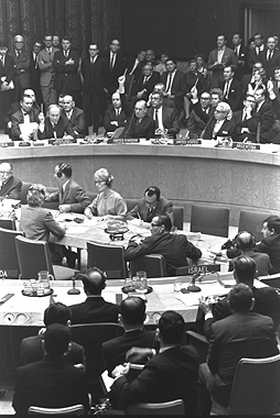
November 22, 1967
In the wake of the June 1967 Six Day War, United Nations Security Council adopts Resolution 242. The Resolution became the context and framework for subsequent official Arab-Israeli negotiations. The central concept in the Resolution was an Israeli exchange of land won in the 1967 War – the Sinai Peninsula, the Golan Heights, portions of Jerusalem, the West Bank and the Gaza Strip – for peace to be granted by Arab neighbors and states.
The Resolution included a formula for achieving peace, namely withdrawal from lands Israel won in the June 1967 War, without establishing specifically how much land should be returned for what nature of peace. It called for “withdrawal of Israeli armed forces from territories occupied in the recent conflict,” without stating how much withdrawal should take place, in the belief that the respective sides would judge what the final borders should be through negotiations. Some believed that any withdrawal from any of the territories satisfied the Resolution’s requirements for withdrawal, while others took the view that withdrawal meant from every area Israel secured in the June 1967 War. On the other hand, the Resolution was specific in its call for the “termination of all claims or states of belligerency and respect for and acknowledgment of the sovereignty, territorial integrity, and political independence of every State in the area and their right to live in peace within secure and recognized boundaries free from threats or acts of force.” It also affirmed the need for “guaranteeing freedom of navigation through international waterways in the area, and for achieving a just settlement of the refugee problem.”
Though the Resolution was drafted in English, it was the French translation that Arab states and supporters of full Israeli withdrawal from the territories constantly cited as the proper meaning and only interpretation of UNSC 242. The reason was simple: in French, the key phrase, “withdrawal of Israeli armed forces from territories occupied in the recent conflict,” is translated as “retrait des forces arrives Isreliennes des territories occupes lores due recent conflit.” The English version intentionally omits the definite article “the” before the word “territories,” leaving imprecise the amount or whereabouts of territory from which Israel might be expected to withdraw.
By contrast, the French text, because of the requirement in the French language to have an article prior to a noun, necessitated the phrase “de territories,” specifying “the” territories, which was often presented by supporters for full or total Israeli withdrawal as “the territories,” or, even more inaccurately, “from all the territories.” The United States UN representative, Arthur Goldberg, and the British representative, Lord Carradon (Hugh Foot), played instrumental roles in the Resolution’s unanimous passage. Both held interesting positions earlier in their careers as public servants: Goldberg had been a U.S. Supreme Court Judge and Carradon had his first posting in Palestine in the 1930s as an administrative official serving in Nablus.
The photo above shows the adoption of Resolution 242 at the United Nations. (Source: United Nations)
Read the complete Resolution: Click Here
